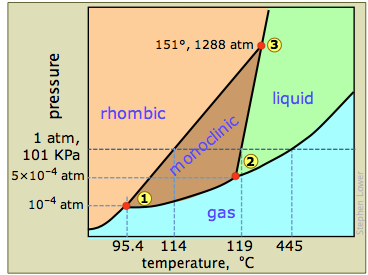How would you explain the phase diagram of sulphur?
1 Answer
Apr 8, 2016
How about this:
Explanation:
A phase diagram is a chart that shows the conditions of pressure and temperature at which distinct phases occur and coexist at equilibrium.
The lines on a phase diagram divide into regions – solid, liquid, and gas.
The phase diagram of sulfur is
 chemwiki.ucdavis.edu
chemwiki.ucdavis.edu
The diagram is complicated by the fact that sulfur can exist in two crystalline forms: rhombic and monoclinic.
Let's look first at the four areas:
- Pink — only rhombic sulfur
- Brown — only monoclinic sulfur
- Green — only liquid sulfur
- Blue — gaseous sulfur
The corresponding curves are:
- lower left to ① — the sublimation curve of rhombic
"S" :"S(rhombic)" ⇌ "S(g)" - ① to② — the sublimation curve of monoclinic
"S" :"S(monoclinic") ⇌"S(g)" - ② to upper right — the vapour pressure curve of liquid
"S" :"S(l)" ⇌ "S(g)" - ① to ③ — the transition curve for
"S(rhombic)" ⇌ "S(monoclinic)" - ② to ③ — the melting point curve for
"S(monoclinic) ⇌ S(l)" - ③ to top — the melting point curve for
"S(rhombic) ⇌ S(l)"
There are three triple points:
- ① (
"95.4 °C", 1 × 10^"-4"color(white)(l) "atm" ) — rhombic"S" is in equilibrium with monoclinic"S" , and both have the same vapour pressure. - ② (
"119 °C", 5× 10^-4color(white)(l) "atm" ) — monoclinic"S" melts; this is the triple point for"S"_"m" ⇌ "S"_"l" ⇌ "S"_"g" . - ③ (
"151 °C, 1288 atm" ) — rhombic, monoclinic, and liquid"S" are at equilibrium.
The critical point — where liquid and gaseous

